mobile View, to the German Version tap the flag


- 1919–1933
- democratic presidential federal State
- also called: "Weimar Republic"
• The term "Weimar Republic"
• Flags
• Meaning/Origin of the Flag
• Coat of Arms
• Meaning/Origin of the Coat of Arms
• The Seal of the German Empire
• Cockade
• Federal States of the German Empire
• Map
• Numbers and Facts
• History
• Origin of the Country's Name
• The term "German Empire"
The term "Weimar Republic" is in the history of the German Empire a synonym for the time span between the coming into force of the civil-republican constitution on the 11th of August in 1919 and Hitler's appointment to the Reichskanzler by the President of the Reich on the 30th of January in 1933. The new Weimar constitution for the empire was a mixture from central and federal elements by a potent status of the imperial president. The legislative organ was the "Reichstag", the countries were represented in the "Reichsrat". The denomination of the state – "German Empire" – obtained though the new constitution, and it was never called a "republic". The term "Weimar Republic" infers from the place of the constitutional conference – the town Weimar – in which first constituent national assembly worked from the 6th of February in 1919 to the 30th of September in 1919. The counsellings were then continued in Berlin to the 21st of May in 1920. The history of the German Empire was characterized by profound changes and crisis situations between November 1918 and the year 1933. They have successfully prevented a communist revolt at the end of the year 1918, there arised new forcible communist uprisings at the begin of the year 1919, which became suppressed by patriotic minded voluntary squads, the so named "free corps". In the year 1920 was the Kapp-Revolt, an uprising of against the republic minded political right circles. Not last they have been forced to give up, by a general strike. During this the communists revolted again in the Ruhr Area. On the 28th of June in 1919 was undersigned the Versailles Dictate by a German delegation, and it came into force on 1st of October in 1920. It was in essential parts unattainable because of the gigantic reparation payments. The USA undersigned not this so-named treaty and arranged an individual peace treaty with the German Empire. The Soviet Union went the same way, too. The German Empire lost as a result of the Versailles Dictate nevertheless all its colonies and 27.000 square miles of his territory. Because of this, and that the reparations were not to pay, France and Belgium occupied the Ruhr Area and began to plunder the German economy. The following economic crisis and even the high inflation caused chaotic conditions in the Empire. In the Rhine Area threats a "Rhine Republic" with separation. Just as Bavaria, which opposed increasable against the central power. And the communists tryed again to exploit this conditions for a coup. But until the year 1924 the situation was stable, at least by farseeing missions of the Reichswehr (army). In the year 1929 arised the world economy crisis, which – together with the results of the Versailles Dictate – forced the German Empire into a deep economical crisis again. Out of this politically difficult situation came Adolf Hitler and his NSDAP as winners, wich seizured the power on 30th of January in 1933 by elections, and they abolished the democracy within short times. In this way finished the period of the "Weimar Republic". The civil-republican constitution was valid out over the end of the war, but stood only partially in power, because of the emergency legislation, and it was changed in some parts.
Source, by: Volker Preuß


1919–1933,
National flag,
ratio = 3:5,
Source, by: Die Welt der Flaggen





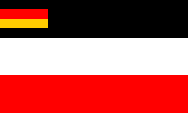
1921–1933,
Merchant flag,
ratio = 3:5,
Source, by: Flags of the World



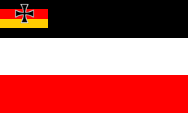
1921–1933,
Merchant flag for naval reserve officers,
ratio = 3:5,
Source, by: Flags of the World



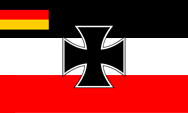
1921–1933,
Naval and war flag,
ratio = 3:5,
Source, by: Die Welt der Flaggen



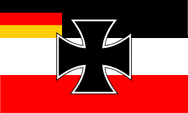
1919–1921,
Naval jack,
ratio = 3:5,
Source, by: Flags of the World



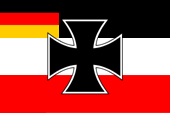
1921–1933,
Naval jack,
ratio = 2:3,
Source, by: Flags of the World



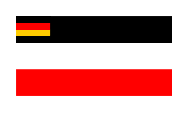
1921–1933,
Pilot jack,
ratio = 3:5,
Source, by: Flags of the World



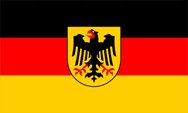
1919–1933,
Official flag for authorities ashore,
ratio = 3:5,
Source, by: Flags of the World



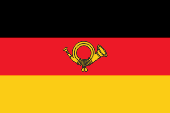
1919–1920,
Flag of the German Imperial Postal Service,
ratio =
2:3,
Source, by: Jürgen Kaltschmitt



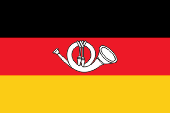
1920–1921,
Flag of the German Imperial Postal Service,
ratio =
2:3,
Source, by: Jürgen Kaltschmitt



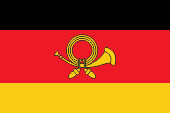
1921–1933,
Flag of the German Imperial Postal Service,
ratio =
2:3,
Source, by: Jürgen Kaltschmitt



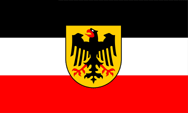
1921–1926,
Official flag for authorities offshore,
ratio = 3:5,
Source, by: Flags of the World



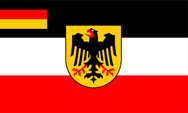
1926–1933,
Official flag for authorities offshore,
ratio = 3:5,
Source, by: Die Welt der Flaggen



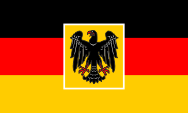
1919–1921,
Flag of the Empire's President,
Source, by: Die Welt der Flaggen



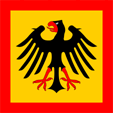
1921–1926,
Standard of the Empire's President,
Source, by: Die Welt der Flaggen



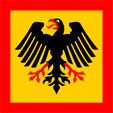
1926–1933,
Standard of the Empire's President,
ratio = 3:5,
Source, by: Snamjena Germanii



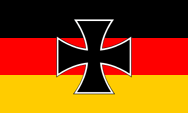
1919–1921,
Flag of the Minister of Defense,
ratio = 3:5,
Source, by: Flags of the World



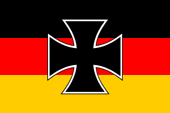
1921–1933,
Flag of the Minister of Defense,
ratio = 2:3,
Source, by: Flags of the World









By the adoption of a civil-republican constitution for the German Empire they meant to make even an official change of the heraldic symbolism. The empire's eagle, hitherto imperial shaped, got essentialy simplified and carrys no breast shield anymore. As national flag was adoped the black-red-golden flag from the revolutionar years of the German Confederation. All remaining flags, especially the sea flags, became, irrespective of smaller changes, in essentials maintained from the Monarchic German Empire however added by a little black-red-golden flag in the upper corner. In the Constitution of the 11th of August in 1919 is written about that in article 3: "The imperial colours are black-red-gold. The merchant flag is black-white-red with the imperial colours in the upper inside corner." In addition to this was legally valid the "Decree of the Imperial President on the German Flag" from the 11th of April in 1921 (RGBl. p. 483) and from 5th of May in 1926 (RGBl. I, p. 217), and the "Announcement of the Imperial President on the imperial coat of arms and the imperial eagle" from the 11th of November in 1919 (RGBl. p . 1877).
The flags of the German Empire seem therewith as a mixture of democratic-civil symbols and symbols of the empire. It is possible to see them as a concession to the political right-wingers respectively to the monarchists, in view of the unsteady political situation in Germany. Certainly is this correct, but if one looks however exacter is to detect that the ashore used flags appear in black, red and gold, and only the sea flags became maintained in black, white and red. This coheres causally therewith, that the Hansetic Cities did not want to renounce the customary appearance of their black-white-red flaged merchant ships. This viewpoint has likewise contributed that the distinctive marks of the German Empire in the sea were maintained essentially unchanged. On 5th of May in 1926 was enacted a new Flag Regulation by the President of the Empire v. Hindenburg. According to it the German overseas missions and in missions european trading ports had to show the merchant flag, except the empire's flag (black, red and gold). That was valid to 1933.
The official flags showed not the coat of arms of the state in their center, but the so-called federal shield. The representation of the eagle in the federal shield differed from that in the national coat of arms.
Meaning and origin of the black-white-red flag ← please read here
Meaning and origin of the black-red-golden flag ← please read here
A special form of flags are the banners, long-stretched flags, which are frequently fixed on a narrow crossbar. Informations about German banners and banner flags ← please read here
Source: Volker Preuß, Jürgen Kaltschmitt

Read here:
Informations, history and facts about the theme "postal flags".


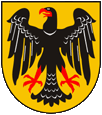
1919–1928,
Coat of arms of the German Empire,
Source, by: Wikipedia (D),
Jürgen Kaltschmitt

1928–1935,
Coat of arms of the German Empire,
Source, by: Wikipedia (D),
Jürgen Kaltschmitt

The coat of arms of the German Empire showed even between 1919 and 1935 a red armed black eagle on golden ground, but it became redesigned in 1928. This design took over the Federal Republic of Germany in 1949 for its coat of arms. The eagle is a very old symbol, which goes back to the military field signs of the Roman legions. These have consisted in a vertical hold-stick, and on its upper end was fixed a crossbar. On this crossbar sat an eagle. The coat of arms of the Holy Roman Empire of German Nation showed a black eagle in a golden field. The image of the eagle was already popular at the Roman emperors, and it appears in the middle ages except of the empire's flag even on German coins, to symbolize even there the continue of the Roman emperorship. Since the Middle Ages, the German imperial eagle has a natural model: the stone eagle (Aquila Chrysaetos). About the origin of the eagle ← please read here. (Nascence and origin of the color red in the imperial eagle ← please read here)
Source, by: Volker Preuß, Jürgen Kaltschmitt

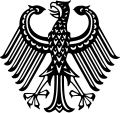
1922–1936,
The seal and lesser coat of arms of the German Empire
The seal was created by the artist Sigmund von Weech in 1921, and officially introduced for the German Empire in 1922, with the "Decree on the Seals". It was used until 1936, then abolished. After the Second World War it was adopted again in 1950 for the Federal Republic of Germany.
Source:
Jürgen Kaltschmitt, Wikipedia (D)


1918–1933, Cockade of the German Empire

Read here:
Informations, history and facts about the theme "Cockades".

Cockade

• Free State of Anhalt
• Free State of Baden
• Free State of Bavaria
• Free State of Brunswick
• Free and Hanseatic Town Bremen
• Free and Hanseatic Town Hamburg
• People's State of Hessen (Hessen-Darmstadt)
• Free State of Lippe (-Detmold)
• Free and Hanseatic Town Luebeck
• Free State of Mecklenburg-Schwerin
• Free State of Mecklenburg-Strelitz
• Free State of Oldenburg
• Free State of Prussia
• Free State of Saxony
• Free State of Schaumburg-Lippe
• Country of Thuringia
• Free State of Waldeck (1929 zu Preußen)
• Free People's State of Wuerttemberg

• Saar Area
• Memel Area
• Danzig


Source:
Wikipedia (D),
By kgberger [GFDL,
CC-BY-SA-3.0 or CC
BY 2.5],
via Wikimedia Commons
für eine große Landkarte – for a big map:
hier klicken – click here

Area: 180.999 square miles (1925)
Inhabitants: 62.411.000 (1925)
Density of Population: 345 inh./sq.mi. (1925)
Capital: Berlin
official Language: German
Currency 1871–1924: 1 Mark = 100 Pfennig
Currency 1924–1948: 1 Reichsmark (RM) = 100 Reichspfennig (Rpf.)
Source:
Wikipedia (D),
Der Michel

1914–1918 · First World War, an alliance of the German Empire with Austria-Hungary presses the German Empire on the side of the Central Powers into the war, because of the by Russia declared war on Austria-Hungary, after success and peace treaty on the eastern front, follows defeat is on the Western Front because of the intervention of the United States, in the German Empire arises the civic November Revolution, overthrow of the monarchy in the kingdom and in the federal states
9th of November in 1918 · proclamation of the Republic (also known as Weimar Republic, because the constitution was created in Weimar)
28th of June in 1919 · Dictate of Versailles, peace treaty between the German Empire and the Allies after the First World War, the German Empire is not involved in the negotiations and is – under the threat of occupation – forced to sign, the solely guilt on war of the German Empire becomes determined, the German Empire loses all its colonies and 27.000 sq.mi. of its territory, must disarm its army to 100.000 men, and suffer a 15 years enduring occupation of the River Rhine left-bank areas and pay gigantic reparations
1923–1925 · France and Belgium occupy the Ruhr Area
1929 · the global economic crisis and the results of the Versailles Dictate hit Germany hard, deterioration of the situation in the country, over the years escalation of the political situation, arise of extreme political left and right parties
1930 · governments of presidential cabinets of Imperial President Paul von Hindenburg rule by emergency decree, France withdrews from the Rhineland
30th of January in 1933 · Hitler's appointment to the Reichskanzler by the President of the Reich
24th of March in 1933 · The democratic parties in the Reichstag cede under the influence of extreme leftist actions and attacks the sovereignty of the parliament as the legislator to the government under the leadership of the National Socialists, the Weimar Constitution is suspended, the National Socialist rule becomes now dictatorial and installs a totalitarian national socialist one-party regime, establishment of the so called "Third Reich".
Source: Wikipedia (D),
Atlas zur Geschichte,
Discovery '97,
Volker Preuß

Germany is the land of the Germans. The Germans themselves are not a growed nation in the usual sense, but originally an alliance of Germanic tribes. The Gemans call themselves "Deutsche". The word "Deutsche" comes from the ancient word "teudisk", what translated means "belonging to the tribe." It was used by the tribes which have spoken the "Theodisk" language, which goes back to the tribe of the Teutons. In 843 the Teutons were first called as "Teutisci". Over the yearhundreds "teudisk" became to "tiutsch" and later "deutsch". Neighboring nations or tribes, who were not "teudisk" took over the word for the Germans. In this way the Italians say: "Tedeschi", the Germanic Scandinavians: "Tysk" the Dutchman: "Duitse". Others simply called the "teudisk" as Germans, even if they were Germanic themselves, so the English: "Germans", but other nations acted in the same way, e.g. the Greeks: "Germanoi", or the Romanians: "Germani". Other neighbors took over the name of the tribe, with whom they had to do on their border, over all the tribes of the land, so the Frenchman: "Allemand," which goes back to the tribe of the Alemanni. This is internationally widespread. The Finns, call the Germans "Saksa," which goes back to the tribe of the Saxons. The Russians call Germany "Germania", but the inhabitants and their language they call "Nemjetski", which can be translated with "the dumb" because the Germans in Russia was once forbidden to speak their own language. Even this "Nemjetski" became widespread, so in all Slavic languages and as well as in the Hungarian language as "Nemat".
Source: Handbuch der geographischen Namen,
Volker Preuß

The documents of capitulation of the German War Might of the 7th of May in 1945 and of the 9th of May in 1945 finished indeed the struggles, but not the existence of the German Empire. The government of the empire became arrested on the 23rd of May in 1945. A peace treaty was not signed, neither with the FRG nor with the former GDR, and is lacking until today.
The Federal Constitution Court in Karlsruhe (President Prof. Dr. Jutta Limbach) decided on 31st of July in 1973 [BVerfGE Bd. 36, 1-37 (LT1-9) BGBl I 1973, 1058] and on the 21st of October in 1987 [Bd.77, S.137,150,154,160,167] unanimous and how intended, that the German Empire in 1945 not perished but continued. Page 15 to 16: ... "The Grundgesetz (Basic Law) – not only a thesis of the International Law and of the State Law sees that the German Empire outlasted the breakdown of 1945 and neither perished by the capitulation nor by the exertion of foreign state power in Germany by the allied occupation mights nor perished later; this is to recognize from the preamble, from article 16, article 23, article 116 and article 146 of the Basic Law. This corresponds to the jurisdiction of the Federal Constitution Court in which the senat persists. ...
The German Empire (see e.g. BVerfG, 1956-08-17, 1 BvB 2/51, BVerfGE 2, 266 (277); 3,288 (319f); 5,85 (126); 6,309, 336, 363) owns still competence in law, but is as whole state not able to act by itself because of lacking organization, especially because of lacking institutionalized organs ... the responsibility for „Germany as whole thing" (= German Empire) have – even – the four mights. The Federal Republic of Germany is in this way not "successor in law" of the German Empire, but identical as state with the state of the "German Empire", – under reference to its territorial expanse only "partially identical", so that insofar the identity demands no exclusivity. The Federal Republic of Germany includes in this way, concerning its state people and its state territory, not the whole Germany regardless of that it recognizes a consistent state people of the subject of the International Law "Germany" (German Empire) ... and a consistent state territory „Germany" (German Empire) ... It (= Federal Republic of Germany) limits its sovereignty in legal terms of state to the field of application of the Basic Law.
"The Federal Republic of Germany agrees the statement of the four mights and emphasizes that the in this statement mentioned incidents and circumstances will not occure, what means, that a peace treaty or a peace regulation is not intended". Protocol of the Bureau of the Federal Chancellor in negotiations of the 17th of July on 1990 in Paris, appendix No. 354 B. (furthermore dissertation of Dr. Michael Rensmann, occupation law in the re-united Germany)
Due to a so-called "small request" out of the Bundestag on 20th of February in 2015, question 27, answered the government of the Federal Republic of Germany: "The Federal Constitutional Court has found in consistently jurisdiction that the "German Empire" - as a subject of international law - is not extincted and the Federal Republic of Germany is not the successor, but identical with it is a subject of international law ... legal basis: BVerfGE 36, pp 1, 16;. and BVerfGE 77, p 137, 155. Source: subject of international law "German Empire" - Foreign - response - from 30th of June 2015: bundestag.de













![]()





































